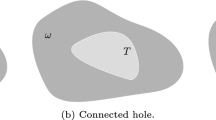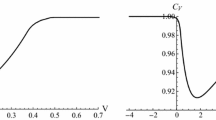Abstract
The Rayleigh Conjecture for the bilaplacian consists in showing that the clamped plate with least principal eigenvalue is the ball. The conjecture has been shown to hold in 1995 by Nadirashvili in dimension 2 and by Ashbaugh and Benguria in dimension 3. Since then, the conjecture remains open in dimension \(d\ge 4\). In this paper, we contribute to answer this question, and show that the conjecture is true in any dimension as long as some special condition holds on the principal eigenfunction of an optimal shape. This condition regards the mean value of the eigenfunction, asking it to be in some sense minimal. This main result is based on an order reduction principle allowing to convert the initial fourth order linear problem into a second order affine problem, for which the classic machinery of shape optimization and elliptic theory is available. The order reduction principle turns out to be a general tool. In particular, it is used to derive another sufficient condition for the conjecture to hold, which is a second main result. This condition requires the Laplacian of the optimal eigenfunction to have constant normal derivative on the boundary. Besides our main two results, we detail shape derivation tools allowing to prove simplicity for the principal eigenvalue of an optimal shape and to derive optimality conditions. Finally, because our first result involves the principal eigenfunction of a ball, we are led to compute it explicitly.

Similar content being viewed by others
References
Adolfsson, V.: \(L^2\)-integrability of second-order derivatives for Poisson’s equation in nonsmooth domains. Math. Scand. 70(1), 146–160 (1992). https://doi.org/10.7146/math.scand.a-12391
Antunes, P.R.S., Buoso, D., Freitas, P.: On the behavior of clamped plates under large compression. SIAM J. Appl. Math. 79(5), 1872–1891 (2019). https://doi.org/10.1137/19M1249606
Ashbaugh, M.S., Benguria, R.D.: On Rayleigh’s conjecture for the clamped plate and its generalization to three dimensions. Duke Math. J. 78(1), 1–17 (1995). https://doi.org/10.1215/S0012-7094-95-07801-6
Ashbaugh, M.S., Laugesen, R.S.: Fundamental tones and buckling loads of clamped plates. Ann. Scuola Norm. Sup. Pisa Cl. Sci. (4) 23(2), 383–402 (1996)
Baricz, Á., Ponnusamy, S., Singh, S.: Cross-product of Bessel functions: monotonicity patterns and functional inequalities’. Proc. Indian Acad. Sci. Math. Sci. 128(3) (2018), Paper No. 36, 30. https://doi.org/10.1007/s12044-018-0398-z
Bennett, A.: Symmetry in an overdetermined fourth order elliptic boundary value problem. SIAM J. Math. Anal. 17(6), 1354–1358 (1986). https://doi.org/10.1137/0517095
Buoso, D.: Analyticity and criticality results for the eigenvalues of the biharmonic operator. Geometric properties for parabolic and elliptic PDE’s, Springer Proc. Math. Stat., vol. 176, pp. 65–85. Springer, Cham (2016). https://doi.org/10.1007/978-3-319-41538-3_5
Buoso, D., Lamberti, P.D.: Eigenvalues of polyharmonic operators on variable domains. ESAIM Control Optim. Calc. Var. 19(4), 1225–1235 (2013). https://doi.org/10.1051/cocv/2013054
Buoso, D., Lamberti, P.D.: On a classical spectral optimization problem in linear elasticity. New trends in shape optimization, vol. 166. Internat. Ser. Numer. Math., pp. 43–55. Birkhäuser/Springer, Cham (2015) https://doi.org/10.1007/978-3-319-17563-8_3
Coffman, C.V., Duffin, R.J., Shaffer, D.H.: The fundamental mode of vibration of a clamped annular plate is not of one sign. In: Constructive Approaches to Mathematical Models (Proc. Conf. in honor of R. J. Duffin, Pittsburgh, Pa., 1978), pp. 267–277. Academic Press, New York-London-Toronto (1979)
Dalmasso, R.: Un problème de symétrie pour une équation biharmonique. Ann. Fac. Sci. Toulouse Math. (5) 11(3), 45–53 (1990)
Duffin, R.J., Shaffer, D.H.: On the modes of vibration of a ring-shaped plate. Bull. Am. Math. Soc. 58(6), 652 (1952). https://doi.org/10.1090/S0002-9904-1952-09650-6
Friedman, A., McLeod, B.: Strict inequalities for integrals of decreasingly rearranged functions. Proc. R. Soc. Edinb. Sect. A 102(3–4), 277–289 (1986). https://doi.org/10.1017/S0308210500026366
Gazzola, F., Grunau, H.-C., Sweers, G.: Polyharmonic boundary value problems, vol. 1991. Lecture Notes in Mathematics. Positivity preserving and nonlinear higher order elliptic equations in bounded domains, pp. xviii+423. Springer, Berlin (2010). https://doi.org/10.1007/978-3-642-12245-3
Gradshteyn, I.S., Ryzhik, I.M.: Table of integrals, series, and products. Eighth. Translated from the Russian, Translation edited and with a preface by Daniel Zwillinger and Victor Moll, Revised from the seventh edition, pp. xlvi+1133. Elsevier/Academic Press, Amsterdam (2015)
Haug, E.J., Rousselet, B.: Design sensitivity analysis in structural mechanics. II. Eigenvalue variations. J. Struct. Mech. 8(2), 161–186 (1980). https://doi.org/10.1080/03601218008907358
Henrot, A.: Extremum problems for eigenvalues of elliptic operators. Frontiers in Mathematics, p. x+202. Birkhäuser Verlag, Basel (2006). https://doi.org/10.1007/3-7643-7706-2
Henrot, A., Pierre, M.: Variation et optimisation de formes, vol. 48. Mathématiques & Applications (Berlin). Une analyse géométrique, pp. xii+334. Springer, Berlin (2005). https://doi.org/10.1007/3-540-37689-5
Ikebe, Y., Kikuchi, Y., Fujishiro, I.: Computing zeros and orders of Bessel functions. In: Proceedings of the International Symposium on Computational Mathematics (Matsuyama, 1990), vol. 38(1–3), pp. 169–184 (1991). https://doi.org/10.1016/0377-0427(91)90169-K
Kawohl, B.: Rearrangements and convexity of level sets in PDE. Vol. 1150. Lecture Notes in Mathematics, pp. iv+136 (1985). Springer, Berlin. https://doi.org/10.1007/BFb0075060
Kesavan, S.: Symmetrization & applications. Vol. 3. Series in Analysis, pp. xii+148. World Scientific Publishing Co. Pte. Ltd., Hackensack (2006). https://doi.org/10.1142/9789812773937
Kristály, A.: Fundamental tones of clamped plates in nonpositively curved spaces. Adv. Math. 367, 107113, 39 (2020). https://doi.org/10.1016/j.aim.2020.107113
Kristály, A.: Lord Rayleigh’s conjecture for vibrating clamped plates in positively curved spaces. Geom. Funct. Anal. 32(4), 881–937 (2022). https://doi.org/10.1007/s00039-022-00606-7
Lamberti, P.D., Lanza de Cristoforis, M.: A real analyticity result for symmetric functions of the eigenvalues of a domain dependent Dirichlet problem for the Laplace operator. J. Nonlinear Convex Anal. 5(1), 19–42 (2004)
Leylekian, R.: Towards the Optimality of the Ball for the Rayleigh Conjecture Concerning the Clamped Plate. Arch. Ration. Mech. Anal. 248(2), Paper No. 28 (2024). https://doi.org/10.1007/s00205-024-01972-2
Mohr, E.: Über die Rayleighsche Vermutung: unter allen Platten von gegebener Fläche und konstanter Dichte und Elastizität hat die kreisförmige den tiefsten Grundton. Ann. Mat. Pura Appl. (4) 104, 85–122 (1975). https://doi.org/10.1007/BF02417012
Nadirashvili, N.S.: Rayleigh’s conjecture on the principal frequency of the clamped plate. Arch. Ration. Mech. Anal. 129(1), 1–10 (1995). https://doi.org/10.1007/BF00375124
Ortega, J.H., Zuazua, E.: Generic simplicity of the spectrum and stabilization for a plate equation. SIAM J. Control Optim. 39(5), 1585–1614 (2000). https://doi.org/10.1137/S0363012900358483
Payne, L.E., Schaefer, P.W.: Duality theorems in some overdetermined boundary value problems. Math. Methods Appl. Sci. 11(6), 805–819 (1989). https://doi.org/10.1002/mma.1670110606
Serrin, J.: A symmetry problem in potential theory. Arch. Ration. Mech. Anal. 43, 304–318 (1971). https://doi.org/10.1007/BF00250468
Stollenwerk, K.: Existence of an optimal domain for minimizing the fundamental tone of a clamped plate of prescribed volume in arbitrary dimension. arXiv:2109.01455 (2021)
Szegö, G.: On membranes and plates. Proc. Nat. Acad. Sci. USA 36, 210–216 (1950). https://doi.org/10.1073/pnas.36.3.210
Talenti, G.: Elliptic equations and rearrangements. Ann. Scuola Norm. Sup. Pisa Cl. Sci. (4) 3(4), 697–718 (1976)
Talenti, G.: On the first eigenvalue of the clamped plate. Ann. Mat. Pura Appl. (4) 129, 265–280 (1981). https://doi.org/10.1007/BF01762146
Tolsa, X.: Unique continuation at the boundary for harmonic functions in \(C^1\) domains and Lipschitz domains with small constant. Commun. Pure Appl. Math. 76(2), 305–336 (2023). https://doi.org/10.1002/cpa.22025
Willms, N.B.: An isoperimetric inequality for the buckling of a clamped plate. Lecture at the Oberwolfach meeting on “Qualitative properties of PDE”(organized by H. Berestycki, B. Kawohl, and G. Talenti) (1995)
Acknowledgements
I would like to thank Enea Parini and François Hamel for their valued support and useful comments during the elaboration of this document. Let me thank Davide Buoso profusely for useful discussions and for having brought to my attention several interesting references on shape derivatives.
Author information
Authors and Affiliations
Corresponding author
Additional information
Publisher's Note
Springer Nature remains neutral with regard to jurisdictional claims in published maps and institutional affiliations.
Appendix
Appendix
Proof of Proposition 15
For readability, we ommit the subscript B in \(u_B\). According to [3], in B, the first eigenfunction is radially symmetric and of the form \(\forall r\in [0,R)\),
where \(k:=\Gamma (B)^{\frac{1}{4}}\). Then, using the identities \(J_\nu '(x)=\frac{\nu J_\nu (x)}{x}-J_{\nu +1}(x)\) and \(I_\nu '(x)=\frac{\nu I_\nu (x)}{x}+I_{\nu +1}(x)\) we find
Now, for u to fulfill the condition \(u(R)=\partial _r u(R)=0\) although being non trivial, one observes that the matrix
needs having a non trivial kernel. In other words, its determinant needs to vanish, hence
Conversely, as soon as k satisfies this equation, u will be solution of an eigenvalue problem in B with Dirichlet boundary conditions. Consequently, k is necessarily the lowest positive solution of this equation, meaning that \(kR=\gamma _\nu \). Hence \(\Gamma (B)=\gamma _\nu ^4/R^4\).
Furthermore, since \(I_\nu >0\) over \((0,\infty )\), \(M\ne 0\) and it has a one-dimensional kernel. By virtue of the identity \(u(R)=0\), the kernel is generated by the vector \((I_\nu (\gamma _\nu ),-J_\nu (\gamma _\nu ))\) or equivalently by the vector \(R^\nu (J_\nu (\gamma _\nu )^{-1},-I_\nu (\gamma _\nu )^{-1})\). In other words, there exists a real number \(\beta \) such that
Finding the values of a and b is thus equivalent to determining \(\beta \). For that purpose, we use the normalisation of u, i.e.
As \(d-2\nu -1=1\), it turns out that we need to compute the integral of product of Bessel functions against r. That’s why we use the Gradshteyn and Ryzhik collection [15, section 6.521, formula 1], that is, for all \(\alpha \ne \beta \in \mathbb {C}\) and \(\nu >-1\),
We apply this formula with \(\alpha =i\gamma _\nu \) and \(\beta =\gamma _\nu \), and find
For the other integrals, we first remark that when (\(\alpha ,\beta \in \mathbb {R}\) and) \(\alpha \rightarrow \beta \) in (22), one obtains
Hence, with \(\beta =\gamma _\nu \), we find
But because both extremal members in (23) depend holomorphicly on \(\beta \), this formula remains true even when \(\beta \in {\mathbb {C}}\) thanks to the isolation of zeros, hence, we can apply it to \(\beta =i\gamma _\nu \):
Finally, since \(f_\nu (\gamma _\nu )=0\), the term between brackets in (21) becomes
Using \(|\mathbb {S}^{d-1}|R^d=d|B|\), we have that \(\beta ^{-2}=|\mathbb {S}^{d-1}|R^{2\nu +2}=d|B|\), hence
In particular,
which corresponds to (17). After having obtained the expression of u, we would like to compute its integral. Observing that
it remains only to compute
for which we used the identities \(J_{\nu +1}'(x)=J_\nu (x)-\frac{\nu +1}{x}J_{\nu +1}(x)\) and \(I_{\nu +1}'(x)=I_\nu (x)-\frac{\nu +1}{x}I_{\nu +1}(x)\). As a result, we get
Note that the last equality in (18) comes from the fact that \(f_\nu (\gamma _\nu )=0\). \(\square \)
Rights and permissions
Springer Nature or its licensor (e.g. a society or other partner) holds exclusive rights to this article under a publishing agreement with the author(s) or other rightsholder(s); author self-archiving of the accepted manuscript version of this article is solely governed by the terms of such publishing agreement and applicable law.
About this article
Cite this article
Leylekian, R. Sufficient conditions yielding the Rayleigh Conjecture for the clamped plate. Annali di Matematica (2024). https://doi.org/10.1007/s10231-024-01454-y
Received:
Accepted:
Published:
DOI: https://doi.org/10.1007/s10231-024-01454-y




